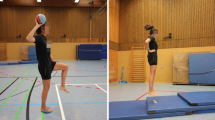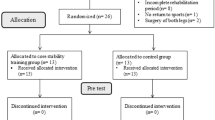Abstract
Purpose
To investigate knee joint function during an unanticipated cutting task between healthy and ACL-reconstructed (ACL-R) females within the same NCAA Division I collegiate female lacrosse team (WLAX) via knee mechanics and estimated vasti and hamstring muscle forces.
Methods
Knee mechanics during three unanticipated cutting trials were observed using 3D motion analysis techniques for 26 healthy female lacrosse players, five which had previous history of ACL-R. Knee flexion angle and knee extensor moment were calculated via Visual3D. Modified musculoskeletal models were used to estimated vasti and hamstrings muscle forces obtained from static optimization. The 2 × 2 (group × limb) repeated measures ANOVAs were used to identify differences in knee mechanics, and vasti and hamstring muscle groups among healthy/ACL-R between their preferred and involved limbs.
Results
There was an interaction between group and limb for knee extensor moment. ACL-R females had less knee extensor moments in their involved limb compared to their uninvolved limb (P < 0.001). There was also a group main effect found for knee flexion angle. ACL-R females cut with less knee flexion angle compared to healthy females (P < 0.013). No significant differences were found for estimated vasti or hamstring forces.
Conclusions
These pilot results indicate that despite all female WLAX players undergoing the same strength and conditioning programming, training sessions, with the same coaching staff, differences in knee joint mechanics still exist between healthy and ACL-R players. These data should help inform larger-scaled studies investigating the impact of ACL-R on athletes within the same sports team.

Similar content being viewed by others
Data Availability
The datasets generated during and/or analyzed during the current study are available from the corresponding author on reasonable request.
References
Agel J, Rockwood T, Klossner D. Collegiate ACL injury rates across 15 sports: national collegiate athletic association injury surveillance system data update (2004–2005 through 2012–2013). Clin J Sport Med. 2016;26(6):518–23. https://doi.org/10.1097/JSM.0000000000000290.
Barber Foss KD, le Cara E, McCambridge T, Hinton RY, Kushner A, Myer GD. Epidemiology of injuries in women’s lacrosse: implications for sport-, level-, and sex-specific injury prevention strategies. Clin J Sport Med. 2018;28(4):406–13. https://doi.org/10.1097/JSM.0000000000000458.
Braun HJ, Shultz R, Malone M, Leatherwood WE, Silder A, Dragoo JL. Differences in ACL biomechanical risk factors between field hockey and lacrosse female athletes. Knee Surg Sports Traumatol Arthrosc. 2015;23(4):1065–70. https://doi.org/10.1007/s00167-014-2873-0.
Brown SR, Washabaugh EP, Dutt-Mazumder A, Wojtys EM, Palmieri-Smith RM, Krishnan C. Functional resistance training to improve knee strength and function after acute anterior cruciate ligament reconstruction: a case study. Sports Health. 2021;13(2):136–44. https://doi.org/10.1177/1941738120955184.
Crowninshield RD, Brand RA. A physiologically based criterion of muscle force prediction in locomotion. J Biomech. 1981;14(11):793–801. https://doi.org/10.1016/0021-9290(81)90035-X.
Delp SL, Anderson FC, Arnold AS, Loan P, Habib A, John CT, Guendelman E, Thelen DG. OpenSim: open-source software to create and analyze dynamic simulations of movement. IEEE Trans Biomed Eng. 2007;54(11):1940–50. https://doi.org/10.1109/TBME.2007.901024.
Devine NF, Hegedus EJ, Nguyen AD, Ford KR, Taylor JB. External match load in women’s collegiate lacrosse. J Strength Cond Res. 2022;36(2):503–7. https://doi.org/10.1519/JSC.0000000000003451.
Elias ARC, Hammill CD, Mizner RL. Changes in quadriceps and hamstring cocontraction following landing instruction in patients with anterior cruciate ligament reconstruction. J Orthop Sports Phys Ther. 2015;45(4):273–80. https://doi.org/10.2519/jospt.2015.5335.
Ford KR, Myer GD, Toms HE, Hewett TE. Gender differences in the kinematics of unanticipated cutting in young athletes. Med Sci Sports Exerc. 2005;37(1):124–9. https://doi.org/10.1249/01.MSS.0000150087.95953.C3.
Ford KR, Nguyen AD, Hegedus EJ, Taylor JB. Vertical jump biomechanics altered with virtual overhead goal. J Appl Biomech. 2017;33(2):153–9. https://doi.org/10.1123/jab.2016-0179.
Ford KR, Schmitt LC, Hewett TE, Paterno MV. Identification of preferred landing leg in athletes previously injured and uninjured: a brief report. Clin Biomech. 2016;31:113–6. https://doi.org/10.1016/j.clinbiomech.2015.09.020.
Gokeler A, Hof AL, Arnold MP, Dijkstra PU, Postema K, Otten E. Abnormal landing strategies after ACL reconstruction. Scand J Med Sci Sports. 2010;20(1):12–9. https://doi.org/10.1111/j.1600-0838.2008.00873.x.
Hall M, Stevermer CA, Gillette JC. Muscle activity amplitudes and co-contraction during stair ambulation following anterior cruciate ligament reconstruction. J Electromyogr Kinesiol. 2015;25(2):298–304. https://doi.org/10.1016/j.jelekin.2015.01.007.
Hamner SR, Seth A, Delp SL. Muscle contributions to propulsion and support during running. J Biomech. 2010;43(14):2709–16. https://doi.org/10.1016/j.jbiomech.2010.06.025.
Harris PA, Taylor R, Thielke R, Payne J, Gonzalez N, Conde JG. Research electronic data capture (REDCap)-A metadata-driven methodology and workflow process for providing translational research informatics support. J Biomed Inform. 2009;42(2):377–81. https://doi.org/10.1016/j.jbi.2008.08.010.
Hopkins WG, Marshall SW, Batterham AM, Hanin J. Progressive statistics for studies in sports medicine and exercise science. Med Sci Sports Exerc. 2009;41(1):3–12. https://doi.org/10.1249/MSS.0b013e31818cb278.
Hubley-Kozey CL, Hill NA, Rutherford DJ, Dunbar MJ, Stanish WD. Co-activation differences in lower limb muscles between asymptomatic controls and those with varying degrees of knee osteoarthritis during walking. Clin Biomech. 2009;24(5):407–14. https://doi.org/10.1016/j.clinbiomech.2009.02.005.
King E, Richter C, Franklyn-Miller A, Daniels K, Wadey R, Jackson M, Moran R, Strike S. Biomechanical but not timed performance asymmetries persist between limbs 9 months after ACL reconstruction during planned and unplanned change of direction. J Biomech. 2018;81:93–103. https://doi.org/10.1016/j.jbiomech.2018.09.021.
Lai AKM, Arnold AS, Wakeling JM. Why are antagonist muscles co-activated in my simulation? A musculoskeletal model for analysing human locomotor tasks. Ann Biomed Eng. 2017;45:2762–74. https://doi.org/10.1007/s10439-017-1920-7.
Lai CCH, Ardern CL, Feller JA, Webster KE. Eighty-three per cent of elite athletes return to preinjury sport after anterior cruciate ligament reconstruction: a systematic review with meta-analysis of return to sport rates, graft rupture rates and performance outcomes. Br J Sports Med. 2018;52(2):128–38. https://doi.org/10.1136/bjsports-2016-096836.
Lustosa LP, Ocarino JM, Andrade MAP, de Pertence AE, de Bittencourt NFNM, Fonseca ST. Muscle co-contraction after anterior cruciate ligament reconstruction: influence of functional level. J Electromyogr Kinesiol. 2011;21(6):1050–5. https://doi.org/10.1016/j.jelekin.2011.09.001.
Lu TW, O’Connor JJ. Bone position estimation from skin marker co-ordinates using global optimisation with joint constraints. J Biomech. 1999;32(2):129–34. https://doi.org/10.1016/S0021-9290(98)00158-4.
Maniar N, Schache AG, Cole MH, Opar DA. Lower-limb muscle function during sidestep cutting. J Biomech. 2019;82:186–92. https://doi.org/10.1016/j.jbiomech.2018.10.021.
Millard M, Uchida T, Seth A, Delp SL. Flexing computational muscle: modeling and simulation of musculotendon dynamics. J Biomech Eng. 2013;135(2):21–32. https://doi.org/10.1115/1.4023390.
Mokhtarzadeh H, Perraton L, Fok L, Muñoz MA, Clark R, Pivonka P, Bryant AL. A comparison of optimisation methods and knee joint degrees of freedom on muscle force predictions during single-leg hop landings. J Biomech. 2014;47(12):2863–8. https://doi.org/10.1016/j.jbiomech.2014.07.027.
Mokhtarzadeh H, Yeow CH, Hong Goh JC, Oetomo D, Malekipour F, Lee PVS. Contributions of the soleus and gastrocnemius muscles to the anterior cruciate ligament loading during single-leg landing. J Biomech. 2013;46(11):1913–20. https://doi.org/10.1016/j.jbiomech.2013.04.010.
Palmieri-Smith RM, Thomas AC, Wojtys EM. Maximizing quadriceps strength after ACL reconstruction. Clin Sports Med. 2008;27(3):405–24. https://doi.org/10.1016/j.csm.2008.02.001.
Paterno MV, Ford KR, Myer GD, Heyl R, Hewett TE. Limb asymmetries in landing and jumping 2 years following anterior cruciate ligament reconstruction. Clin J Sport Med. 2007;17(4):258–62. https://doi.org/10.1097/JSM.0b013e31804c77ea.
Paterno MV, Schmitt LC, Ford KR, Rauh MJ, Myer GD, Hewett TE. Effects of sex on compensatory landing strategies upon return to sport after anterior cruciate ligament reconstruction. J Orthop Sports Phys Ther. 2011;41(8):553–9. https://doi.org/10.2519/jospt.2011.3591.
Paterno MV, Schmitt LC, Ford KR, Rauh MJ, Myer GD, Huang B, Hewett TE. Biomechanical measures during landing and postural stability predict second anterior cruciate ligament injury after anterior cruciate ligament reconstruction and return to sport. Am J Sports Med. 2010;38(10):1968–78. https://doi.org/10.1177/0363546510376053.
Segawa H, Omori G, Koga Y. Long-term results of non-operative treatment of anterior cruciate ligament injury. Knee. 2001;8(1):5–11. https://doi.org/10.1016/S0968-0160(00)00062-4.
US Lacrosse. US Lacrosse Participation Report. In: US Lacrosse. Available via US Lacrosse. 2018. https://www.uslacrosse.org/sites/default/files/public/documents/about-us-lacrosse/2018-participation-report.pdf. Accessed 29 Apr 2022.
Walker PS, Rovick JS, Robertson DD. The effects of knee brace hinge design and placement on joint mechanics. J Biomech. 1988;21(11):965–74. https://doi.org/10.1016/0021-9290(88)90135-2.
Funding
This research did not receive any specific grant from funding agencies in the public, commercial, or not-for-profit sectors.
Author information
Authors and Affiliations
Contributions
All authors (SP, CW, JT, A-DN, AW, EA, MM, and KF) made contributions to the conception, analysis, interpretation of the work. All were involved in drafting and revising the manuscript, giving final approval of the manuscript, and take accountability for all aspects of the current work.
Corresponding author
Ethics declarations
Conflict of Interest
The authors have no relevant financial or non-financial interests to disclose.
Ethics Approval
This study was performed in line with the principles of the Declaration of Helsinki. Approval was granted by the Institutional Review Board of High Point University.
Consent to Participate
Written informed consent was obtained from all individual participants included in the study.
Consent to Publish
The authors affirm that human research participants provided informed consent for publication of the images in Fig. 1.
Rights and permissions
Springer Nature or its licensor (e.g. a society or other partner) holds exclusive rights to this article under a publishing agreement with the author(s) or other rightsholder(s); author self-archiving of the accepted manuscript version of this article is solely governed by the terms of such publishing agreement and applicable law.
About this article
Cite this article
Peel, S.A., Walck, C.D., Taylor, J.B. et al. Knee Joint Function in Healthy and ACL-Reconstructed Collegiate Female Lacrosse Players: A Pilot Study. J. of SCI. IN SPORT AND EXERCISE (2023). https://doi.org/10.1007/s42978-023-00223-2
Received:
Accepted:
Published:
DOI: https://doi.org/10.1007/s42978-023-00223-2




